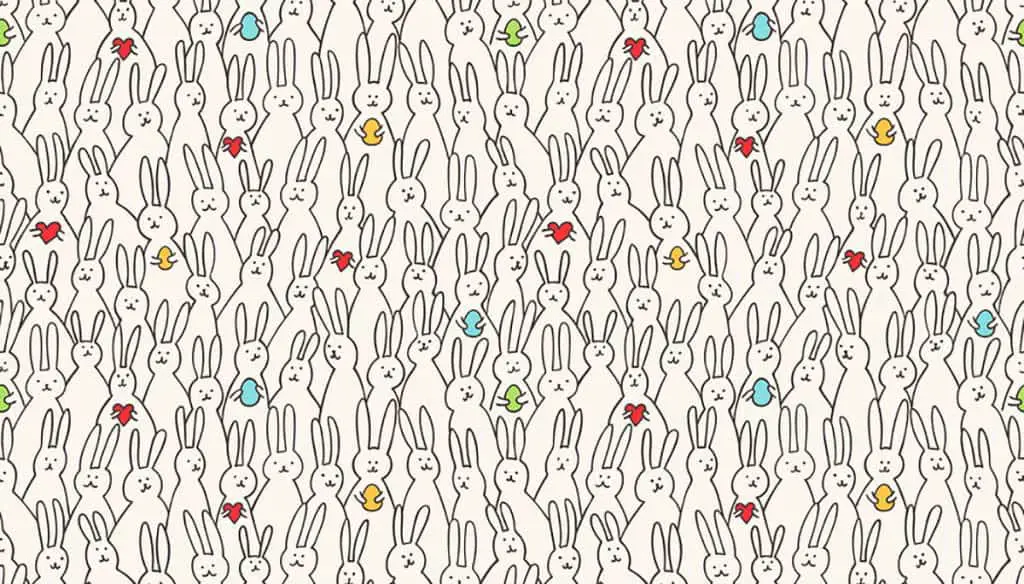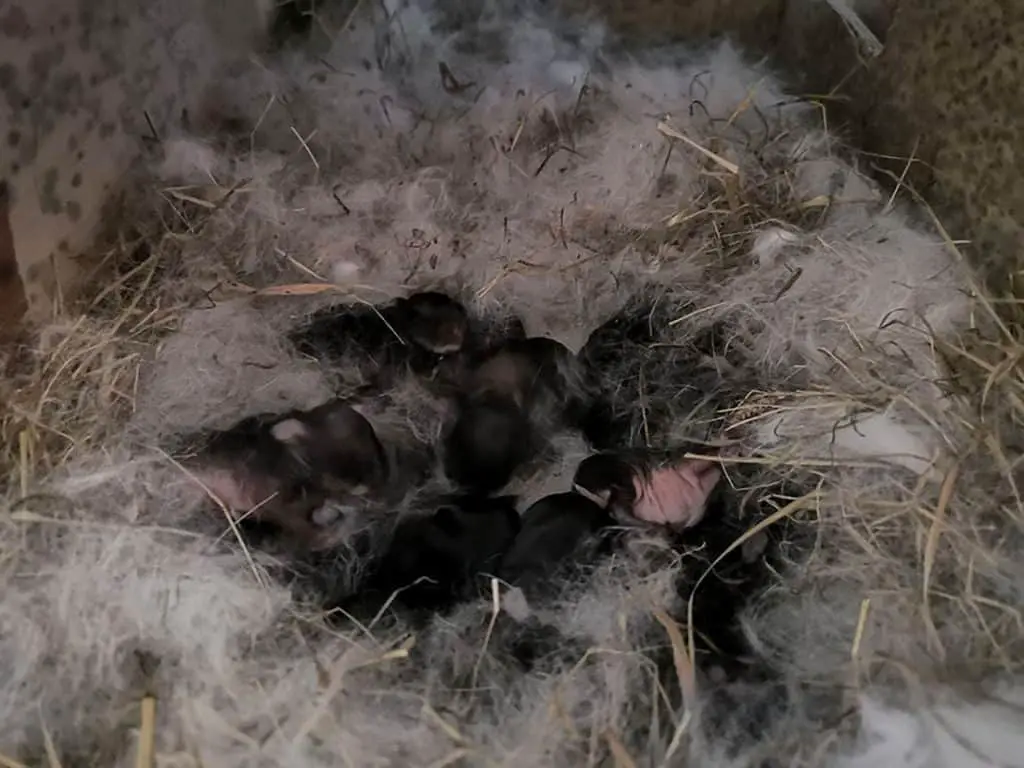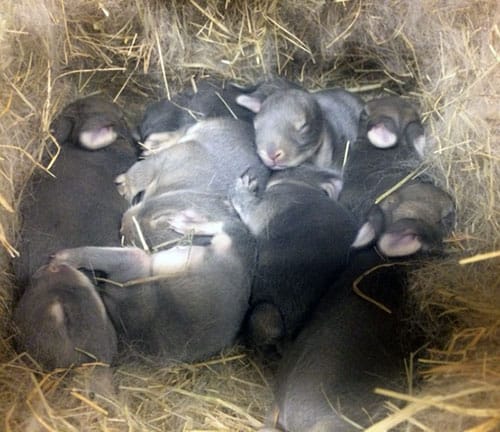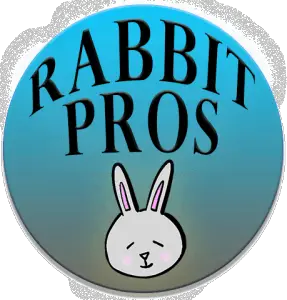Disclosure: We may earn money or products from the companies mentioned in this post.
We’ve all heard the phrase “breeding like rabbits,” but how fast do rabbits really breed and how many litters can a rabbit have per year? More importantly, how many babies can a rabbit have per year?
If a female rabbit is never separated from a male rabbit, the female rabbit can have 11 or 12 litters of bunnies every year with no rest in between litters. This is because the gestation period for a rabbit is only about 30 days, and they can breed again nearly immediately after birth.
However, having this many litters would not be healthy for the doe or for the baby rabbits.
Aggressive rabbit breeders will aim for 6.5 litters per year, though most people who raise rabbits will breed each doe to give birth to only 3 or 4 litters per year.
Let’s dig into the details and find out how many litters really makes sense.
How Many Babies Can A Rabbit Have In A Year?
The maximum number of litters a rabbit can have in one year is 12. The average rabbit litter size is 6 bunnies which means that a female rabbit that is constantly around male rabbits will have on average 72 baby rabbits.
The maximum number of baby rabbits that rabbits can have in a single year is 168. We know this because the maximum number of litters a rabbit could have is 12 per year, and a super large litter size is 14 babies. It is very unlikely that any single doe would have this many babies in a year.
Not only is 168 babies in a single year unlikely, but I’m also comfortable saying that isn’t ever going to really happen. This many litters would be very unhealthy for a doe and, honestly, she probably wouldn’t survive the entire year.
So instead, let’s dig into how many litters and babies a female rabbit can safely have in a year.

How Often Do Rabbits Breed?
A female rabbit is one of a handful of animals that do not need to be in ‘heat’ to be fertile; instead, they are Induced Ovulators. Induced ovulation is the process where coitus (e.g. some form of genital stimulation) causes a surge of Luteinizing Hormone (LH) which causes the female to become fertile.
Induced Ovulators are somewhat rare, and include not only rabbits, but cats, ferrets, and camels.
We’ve all heard the old wives’ tale that a woman will not get pregnant while she’s nursing. I don’t think that’s actually true for humans, and I know it’s not true for rabbits.
Rabbits can get pregnant while still nursing their most recent litter of bunnies, sometimes immediately after giving birth.
Still, even with the physical ability to be fertile at any time, it is not the best strategy to keep your does pregnant year around.
It takes a lot of energy to nurse baby bunnies, and those babies won’t be ready to wean until they are 3 to 6 weeks old (though many breeders prefer 6 to 8 weeks before weaning). While a doe can be impregnated while still nursing babies, it’s not a good idea.
If a doe is spending energy on both nursing an existing litter and growing her next litter, it’s not a crazy thought that both litters will suffer from malnutrition and neither litter will achieve their full potential.
Most rabbit wranglers will let a litter nurse for 6 to 8 weeks before weaning. Then they’ll allow their doe to rest and recuperate for 2 to 4 weeks before breeding again.
This means 12 to 16 weeks between the birth of the first litter to the birth of the second for most does.
This means that most rabbits in an active breeding program will have 3 to 4 litters per year.

Rabbit Breeding Schedules
This is a personal choice.
1. Aggressive Breeding Schedule – Every 8 Weeks
Some who raise rabbits breed them every 8 weeks, which is an aggressive schedule.
4 weeks after the birth, they rebreed the doe while she’s still nursing her first litter; keeping in mind that she’s an Induced Ovulator as we talked about above.
In this model, you’ll breed your doe and have kits (baby rabbits) roughly 4 weeks later.
2 weeks later you wean the first litter of bunnies at 6 weeks old.
2 weeks later you get another litter of rabbits.
An aggressive rabbit breeding schedule will mean that a rabbit can have 6.5 litters per year.
If you choose to follow this aggressive breeding schedule, you will see the wear and tear on your doe. By the 4th or 5th litter, she’ll be a ghost of her old self.
Growing babies while nursing babies greatly depletes her nutrients, and you’ll see the price of that not only in your doe’s health but in the quality of her offspring.
2. Less Aggressive Breeding Schedule – Every 10 Weeks
Most rabbit breeders, even those trying to maximize meat production, choose a less aggressive breeding schedule.
This less aggressive schedule aims for new breedings every 10 weeks.
In this model, like the one above, you’ll breed your doe and have kits (baby rabbits) roughly 4 weeks later.
Then, 6 weeks after the birth, you’ll rebreed the doe while she’s still nursing her first litter.
2 weeks later you wean the first litter of bunnies at 8 weeks old, which will give you much larger and healthier bunnies.
2 weeks later you get another litter of rabbits.
A less aggressive breeding schedule will mean that a doe will have 5.2 litters per year.
You can follow this less aggressive breeding schedule for years, though you should be mindful of the health and wellbeing of your doe and your bunnies. If either is suffering, give them a few more weeks to thrive.
3. Relaxed Breeding Schedule – Every 14 Weeks
If you want to take it easy on your rabbits, let your doe wean and recover before the next breeding.
As always, you’ll breed your doe and have kits (baby rabbits) roughly 4 weeks later.
Then, 8 weeks after the birth, you’ll wean the bunnies.
2 weeks later you’ll breed the doe.
4 weeks later you get another litter of rabbits.
A healthy breeding schedule for domestic rabbits will allow for 3.7 litters per year from a doe and a happy and relaxed colony of rabbits.

Conclusion
Keep in mind that you are the steward or caretaker of your animals, even if you are just raising them to sell. Be kind to your animals and choose a breeding schedule that gives your family and your customers the best quality rabbits you can raise.
~The Rabbit Pros

I enjoyed ur advises to use in breeding a rabbit(doe) I always use the less aggressive method of breeding and I am having healthy bunnies.Am happy learning with you